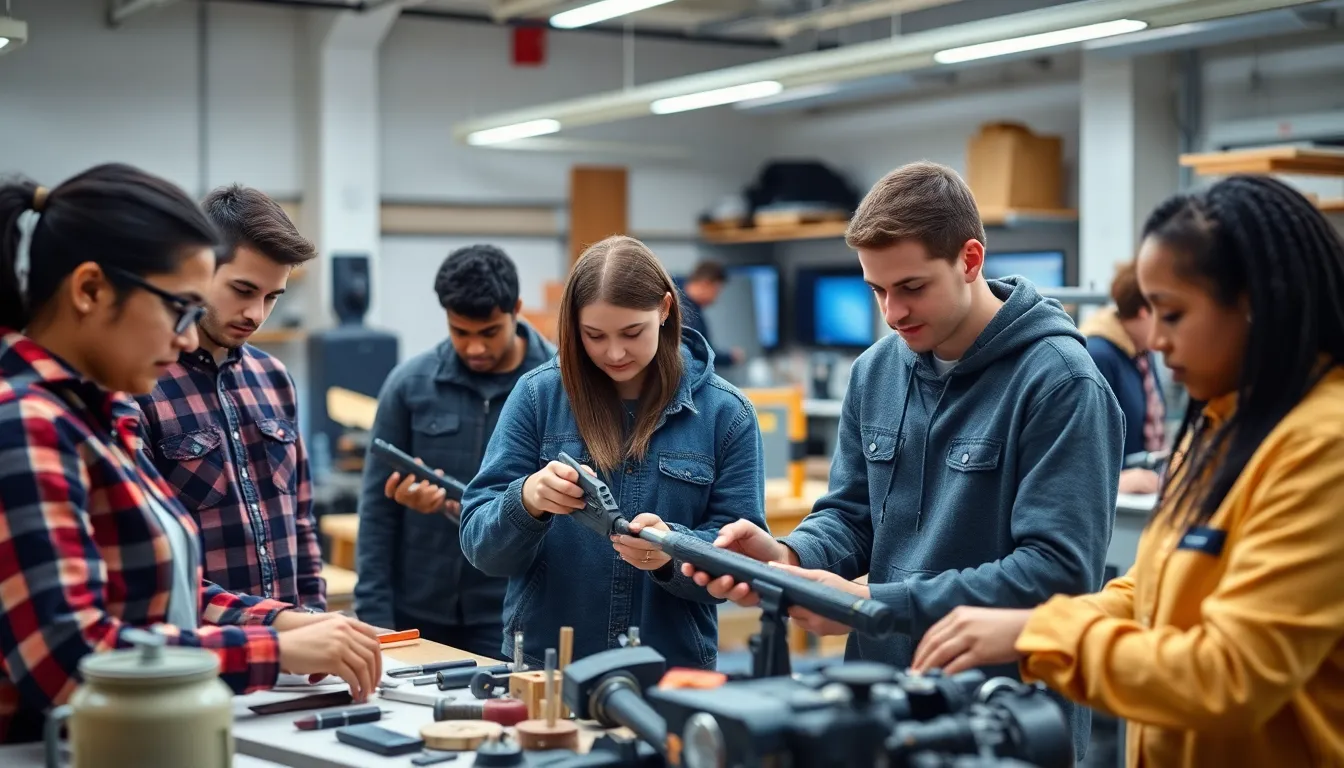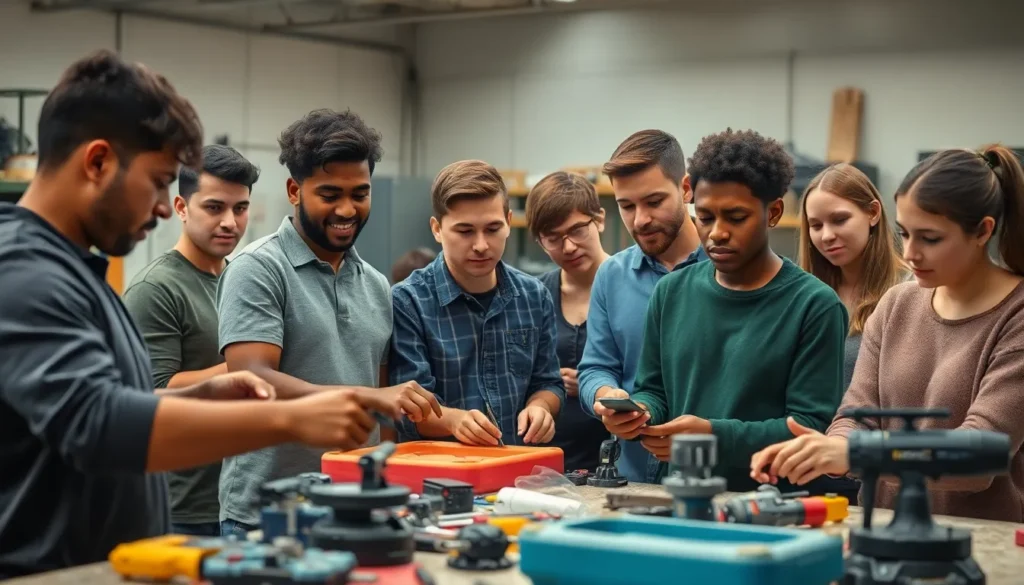Table of Contents
ToggleIn today’s fast-paced job market, integrated vocational education is gaining traction as a vital pathway for students seeking practical skills and real-world experience. This innovative approach combines academic learning with hands-on training, preparing individuals for specific careers while ensuring they meet industry demands.
By bridging the gap between education and employment, integrated vocational education empowers students to acquire essential competencies that enhance their employability. It not only fosters a skilled workforce but also addresses the growing need for specialized talent across various sectors. As more educational institutions adopt this model, the future of vocational training looks promising, offering students a clear route to success in their chosen fields.
Overview of Integrated Vocational Education
Integrated vocational education combines academic instruction with practical skills training, preparing students for specific career paths. This educational approach aligns closely with industry requirements, ensuring relevance and applicability in the job market.
Definition and Key Concepts
Integrated vocational education refers to a system where formal education and hands-on training coexist. It encompasses blended learning environments that incorporate theoretical concepts with real-world application. Key concepts include:
- Work-Based Learning: Students engage in internships and apprenticeships, gaining direct experience in their chosen fields.
- Curriculum Integration: Academic subjects are integrated with vocational training, enhancing the overall learning experience.
- Industry Partnerships: Collaboration with local businesses ensures that training programs meet current labor market needs.
Importance in Today’s Economy
- Skills Gap: Many industries face a shortage of skilled workers, and integrated vocational training helps close this gap by producing job-ready graduates.
- Economic Growth: By equipping individuals with relevant skills, integrated vocational education fosters innovation and drives economic progress.
- Adaptability: The model promotes flexible learning that adapts to emerging technologies and changing job demands, ensuring relevance in a dynamic market.
Benefits of Integrated Vocational Education

Integrated vocational education offers several advantages that enhance both learning and career readiness. This educational model effectively bridges the gap between classroom knowledge and workplace skills.
Skill Development and Competence
Integrated vocational education promotes targeted skill development. Students engage with specific competencies related to their chosen fields, preparing them for actual job requirements. Programs typically include technical training, which cultivates expertise in tools, technologies, and methodologies pertinent to industries. Real-time industry feedback ensures that students acquire relevant skills, enhancing their proficiency and confidence in the workplace.
Real-World Application and Experience
Integrated vocational education facilitates real-world application of learned concepts. Students gain hands-on experience through internships, apprenticeships, and project-based learning. This exposure to genuine workplace environments allows students to apply theoretical knowledge in practical situations. Participating in real projects also helps students develop problem-solving abilities and critical thinking skills, essential for navigating complex work scenarios.
Challenges in Implementing Integrated Vocational Education
Integrated vocational education faces several challenges that hinder its effective implementation. Understanding these obstacles is crucial for developing strategies to optimize this educational approach.
Institutional Barriers
Institutional barriers significantly impede the successful adoption of integrated vocational education. Many educational institutions lack the resources to establish partnerships with industries, resulting in a disconnect between curriculum offerings and labor market needs. Limited funding also restricts program development and the expansion of facilities necessary for hands-on training. Furthermore, faculty may lack the required qualifications or practical experience to teach integrated courses effectively. Administrative resistance to change often exists, as traditional educational models remain deeply ingrained in institutional practices, making it difficult to shift towards a more integrated approach.
Societal Perceptions and Stigma
Societal perceptions and stigma around vocational education present ongoing challenges. Many individuals still associate vocational paths with lower status compared to traditional college degrees, leading to a perception that vocational training is less valuable. This stigma can deter students from pursuing integrated vocational education, fearing judgment from peers or family. Additionally, parents often prioritize higher education for their children, viewing vocational training as a fallback option rather than a viable and rewarding career pathway. Addressing these perceptions requires targeted outreach and advocacy to highlight the benefits and success stories associated with integrated vocational education.
Successful Models of Integrated Vocational Education
Integrated vocational education thrives globally, showcasing effective practices that enhance student readiness for the workforce. Various models demonstrate the value of merging academic studies with practical training.
Case Studies from Around the World
- Germany’s Dual System
Germany employs a dual model where students split time between classroom learning and apprenticeships. Approximately 60% of students engage in this system, which boasts a youth unemployment rate of only 6%. Firms collaborate with schools, ensuring training aligns with industry needs.
- Switzerland’s Vocational Education and Training (VET)
Switzerland’s VET system offers specialized pathways integrating school-based education with workplace training. 70% of Swiss youth opt for vocational training, contributing to their nation’s low unemployment rates and high-skilled workforce.
- Singapore’s SkillsFuture Initiative
Singapore promotes lifelong learning with the SkillsFuture initiative, equipping citizens with relevant skills. This government-funded program emphasizes industry partnerships, allowing for curriculum adjustments based on market demands. The initiative enhances employability across multiple sectors.
- Australia’s Traineeships and Apprenticeships
Australia supports school-based traineeships and apprenticeships that link education with vocational pathways. Over 50% of students in vocational education pursue these programs, driving both student engagement and job readiness.
Lessons Learned and Best Practices
- Build Strong Industry Partnerships
Collaboration between educational institutions and industry players proves vital. Linking curriculum to real-world requirements results in graduates equipped with relevant skills.
- Prioritize Hands-on Experience
Realistic, practical training forms the core of effective models. Internships and workplace simulations enhance problem-solving abilities and boost student confidence.
- Emphasize Career Guidance
Clear pathways and transition support are crucial. Integrating career counseling within vocational education helps students navigate their options and make informed decisions.
- Promote Public Awareness
Addressing stigma around vocational education matters. Campaigns highlighting successful graduates and industry contributions can reshape perceptions and encourage student enrollment.
- Adapt to Technological Advances
Ongoing curriculum updates in response to technological developments maintain relevance. Educators must stay aligned with industry trends to ensure continuous skill alignment.
Integrated vocational education stands as a crucial component in preparing students for the evolving job market. By blending academic knowledge with practical skills, it addresses the pressing need for specialized talent across various industries. This educational model not only enhances employability but also fosters adaptability in an ever-changing economic landscape.
As more institutions adopt integrated approaches, the importance of overcoming existing challenges becomes evident. Building strong industry partnerships and promoting awareness can help dismantle the stigma surrounding vocational education. By focusing on real-world applications and targeted skill development, integrated vocational education paves the way for a brighter future for students and the workforce alike.



